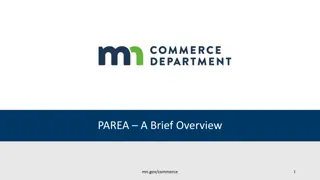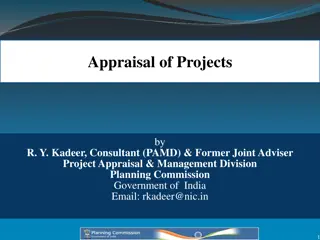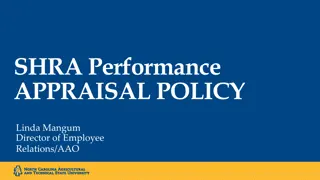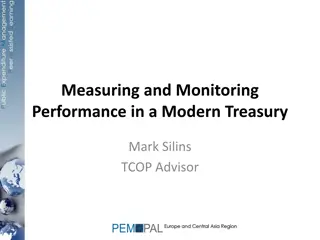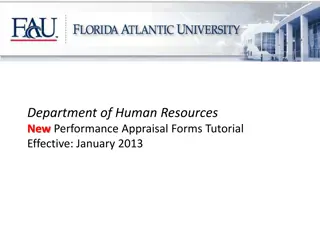Modern Performance Appraisal Methods in Human Resource Management
Performance evaluation methods play a crucial role in assessing and improving employee performance. This content explores six modern performance appraisal methods, including Management by Objectives (MBO), 360-Degree Feedback, Assessment Centre Method, Behaviorally Anchored Rating Scale (BARS), Psychological Appraisals, and Human Resource (Cost) Accounting Method. Each method offers unique benefits in aligning employee goals with organizational objectives and enhancing overall performance.
Download Presentation

Please find below an Image/Link to download the presentation.
The content on the website is provided AS IS for your information and personal use only. It may not be sold, licensed, or shared on other websites without obtaining consent from the author. Download presentation by click this link. If you encounter any issues during the download, it is possible that the publisher has removed the file from their server.
E N D
Presentation Transcript
IDHAYA COLLEGE FOR WOMEN,KUMBAKONAM Semester Subject Subject code Unit Topic :II :Human Resource Management :P16MBA11 :V 1.Performance &Evolution 2.Industry parctices&promotion 3Demotion 4.Gender sensitivity Implication of job change :Mrs .C.Sangeetha, MBA., M.Com., M.Phil., (Ph.D) Assistant Professor Department of Management Idhaya College for Women, Kumbakonam Faculty Name
METHODS OF PERFORMANCE EVALUATION Six modern performance appraisal methods 1. Management by Objectives (MBO) . 2. 360-Degree Feedback. 3. Assessment Centre Method. 4. Behaviorally Anchored Rating Scale (BARS) 5. Psychological Appraisals. 6. Human-Resource (Cost) Accounting Method.
MBO method of performance appraisal 1. Management by objectives commonly referred to as MBO is a performance appraisal method that determines how closely aligned an employee's goals are to organizational goals. 2. MBO appraisals are suitable for measuring quantitative and qualitative output of high-level employees.
360 Degree Feedback 1. 360 Degree Feedback is a system or process in which employees receive confidential, anonymous feedback from the people who work around them. 2. This typically includes the employee's manager, peers, and direct reports.
Assessment Centre Method An assessment centre is a place to evaluate an individual potentiality and performance, so as to position he/she in the core functional areas. The trained evaluators observe and evaluate employees as they perform the assigned jobs and are evaluated characteristics. on job related
Performance Appraisal Methods Assessment Centre Method: The purpose of this method is to test candidates in social situations. Behaviorally Anchored Rating Scale Critical Incident Technique Essay Evaluation Human Asset Accounting Method Management By Objective Paired Comparison Method Rating Scale
Behaviorally Anchored Rating Scale (BARS) Behaviorally anchored rating scales (BARS) are scales used to rate performance It is an appraisal method that aims to combine the benefits of narratives, critical incidents, and quantified ratings by anchoring a quantified scale with specific narrative examples of good, moderate, and poor performance.
Psychological Appraisals Appraisal theory is the theory in psychology that emotions are extracted from our evaluations (appraisals or estimates) of events that cause specific reactions in different people. Essentially, our appraisal of a situation causes an emotional, or affective, response that is going to be based on that appraisal.
Human resource cost Human resource costs are costs incurred to acquire or replace people. Like other. costs, they have expense and asset components; they may be composed of outlay and opportunity costs; and they may have both direct and indirect cost elements.
Here are seven of the most important human resources in manufacturing companies: Talent Acquisition/Recruitment. Compensation Management. Benefits Administration. Training and development. Performance Appraisal and Management. Employee and Labor Relations. Compliance Management.
Performance of Evaluations 1. HRM, being a part of management discipline, has followed the pattern of development of management because of the interrelationship of the problems of both the fields. 2. Human Resource Management (HRM) is relatively a very recent term considered for managing human resources in an organisation. HRM is still evolving to become an amalgam of organisational behaviour, personnel management, industrial relations and labour legislation.
FEEDBACK The performance appraisal is the process of assessing employee performance by way of comparing present performance with already established standards which have been already communicated to employees, subsequently providing feedback to employees about their performance level for the purpose of improving their
INDUSTRY PRACTICE HR best practices Providing security to employees. Selective hiring: Hiring the right people. Self-managed and effective teams. Fair and performance-based compensation/li> Training in relevant skills. Creating a flat and egalitarian organization. Making information easily accessible to those who need it.
Meaning of performance evaluation Performance Evaluation is defined as a formal and productive procedure to measure an employee's work and results based on their job responsibilities. ... Ideally, employees are graded annually on their work anniversaries based on which they are either promoted or are given suitable distribution of salary raises.
Performance of HRM Performance is the systematic evaluation of employee's behavior in the work place which includes employee's job performance and his potential for growth and development. Actually the performance is not the evaluation of performance of job but the evaluation of performance of employee on the job.Performance is the systematic evaluation of employee's behaviour
Methods of performance evaluation 5 common performance evaluation Self evaluation Judgments Wisdom Creativity Skill based evaluation
PERFORMANCE OF HRM Performance is the systematic evaluation of employee's behaviour in the work place which includes employee's job performance and his potential for growth and development. Actually the performance appraisal is not the evaluation of performance of job but the evaluation of performance of employee on the job.Performance appraisal is the systematic evaluation of employee's behaviour
Control system The control system must be suitable for the kind of activity intended to serve. A system of control useful at a higher level of management will be different in scope and nature from that in use at the operative level.
PROMOTION 1. Promotion is vertical movement of an employee within the organization. In other words 2. promotion refers to the upward movement of an employee from one job to another higher one, 3. with increase in salary, status and responsibilities.
Types Of Promotion Horizontal promotion: When an employee is shifted in the same category, it is called 'horizontal promotion' Vertical Promotion Dry Promotion
Bases of promotion Promotion may be on two bases: Merit based promotion: when the promotion takes place on the basis of an employee's performance in the current job. It is done on the basis of his skills, knowledge and ability. Seniority based promotion: Here the employee who has given the long service in the organization gets promoted.
Benefits of promotion Creates differentiation. Creates communication opportunity. Creates word of mouth. Creates a platform to cross-sell and upsell. Creates a reason to buy. Creates a focused marketing approach. Creates greater revenue.
Demotion A demotion refers to a permanent reassignment to a lower position than the employee had worked previously. The position will generally have a lower level of responsibility or required skill, and a lower pay grade than the previous position.
Causes of Demotion Breach of Discipline: A breach of discipline may attract demotion as a punishment. Inadequacy of Knowledge: A person may not be competent to perform his job properly. Unable To Cope With Change: Now-a-days, there is a rapid change in technology and methods of work. Organisational Re-Organisation:
Here are our top tips for dealing with demotions in your workplace Hire and Promote With Care. Evaluate if this is the Right Decision. Speaking to the Employee. Maintain Dignity. Help Your Employee Thrive. Avoid Risk.
Transfer & separation It involves movement of employee from one job to another within an organization while being in the same level of hierarchy, requiring similar skills, involving same level of authority and responsibility and similar pay.
Types of Separation Separation of an employee exists when the service of an employee comes to an end because of one reason or other. Separation arises due to resignation; lay off, dismissal and retirement. Types of separation: i) Resignation: when the employee himself initiates the separation then it is termed as separation
IMPLICATIONS OF JOB CHANGE Changing your job can feel a risky and anxious experience. There may be many reasons why you are changing your job; dissatisfaction at a lack of prospects, wanting more pay or responsibility, feeling undervalued or simply relishing a new challenge
IMPLICATIONS OF JOB CHANGE Good reasons for requesting a job transfer range from career advancement and learning new skills to resolving conflict in your current department. Acquire New Skills. Advancement to a Higher-level Position. Exploring Career Options. Resolving Workplace Conflict. Job Security.
Reasons for transferring Jobs within a Company Life change Seeking growth Improving chances for a promotion. Improving job security. Improving work-life balance
Types of Transfers 1. Production Transfer: 2. Replacement Transfer: 3Versatility Transfer: 4. Shift Transfer:. 5. Penal Transfer: 6. Remedial Transfer:
Control process Control is a management process to aim at achieving defined goals within an established timetable, and comprises of three components: (1) setting standards (2) measuring actual performance, and (3) taking corrective action.
Types of Control Process (1) Establish standards, (2) Measure performance, (3) Compare actual performance with standards and identify any deviations, (4) Determine the reason for deviations, (5) Take corrective action, if needed.
Three basic steps in a control process: Establishing standards. Measuring and comparing actual results against standards. Taking corrective action.
Transfer change in job assignment- horizontal or lateral movement of an employee from one job to another in the same organization without much change in his status or pay package. Transfer causes a shift of individual from one job to another without there being any marked change in his responsibilities, skills and other benefits.
Objective of Transfer 1. To meet or fulfill organizational needs 2. To satisfy employee needs 3. To adjust the workforce 4. To reduce monotony and to make the employees versatile 5. For effective use of employees 6. To punish Employees 7. To give the relief to the employees 8. To improve employees background by placing them in different jobs of various departments and units.
Purpose of Transfer 1. To Increase Productivity of Employees 2. To Fulfil Employee s Request 3. To Meet Organisational Requirements 4. Maintenance of a Tenure System 5. For Adjusting the Work Force 6. For Penalising Employees 7. For Adjusting the Employee s Timing 8. To Make Employee s more Versatile
Types of Transfer Type # 1. Production Transfer Employees are posted in different departments, based on their interests and qualifications. This also depends on the work load that a department possesses. However, this load keeps fluctuating, and the demand for manpower keeps changing with time. For departments with surplus manpower, lay-off is a solution. However, a better solution is the interdepartmental transfer to balance the manpower allocation. In simpler terms, production transfer refers to the transfers ordered to avoid such unavoidable lay-offs.
Type # 2. Replacement Transfer When an employee leaves a department for a particular reason, the department needs a replacement. In such scenarios, especially in demanding situations, a senior employee might have to function in place of the junior employee, till the time a replacement is found. Senior employees are required to work in place of junior employees even in situations of declining production. Thus, replacement transfer also helps in reducing the organizational need for lay-off; particularly for long-service employee.
Type # 3. Versatility Transfer Some organizations believe that the workforce needs to have multiple skills capable to perform multiple tasks. People can achieve multiple skills only by working in different departments. In learning organizations such as ordnance factories, banks, and many private companies, people get the scope of working in different departments and can learn different systems, procedures, and rules and regulations. They gain the necessary skills to attend to the activities in the departments, and ultimately become versatile. People who pick up their tasks quickly emerge to become the company s assets. During rush periods, they are able to contribute greatly to achieve business goals. Versatile transfer may comprise production transfer or replacement transfer.
Type # 4. Shift Transfer In order to enhance capacity utilization, industrial organizations, operate in multiple shifts generally morning, evening, and night shifts. Some organizations allot employees to staggered shifts as well. Employees are engaged in all the shifts on a rotational basis. Requests of employees for transfers on a particularly shift are also entertained, considering the importance of ground of requests. However, conformance to law and administrative procedures are essential requirements to avoid employee unrest. d
Type # 5. Remedial Transfer After induction, employees are placed in a department and jobs are assigned to him/ her, and their performance and behavioural dispositions are recorded. Some employees may emerge as good performers, while many others may emerge as underperformers. In course of time, an employee s inclination to work is also observed. The objective of remedial transfer is therapeutic in nature, that is, to rectify the wrong placement.
GRIEVANCES A grievance is a formal dispute between an employee & management on the conditions of employment. The higher level the grievance and gives his decision on the matter manager goes into
Causes of Grievances Grievances may occur due to a number of reasons: Economic: Employees may demand for individual wage adjustments Work environment: It may be undesirable or unsatisfactory conditions of work. Supervision Organizational change Employee relations Miscellaneous
Redressal Method While the term "Grievance Redressal" primarily covers processing of complaints from citizens and consumers, includes actions taken on any issue raised by them to avail effectively. the receipt and a wider definition services more
Three Types of Grievances Individual grievance. One person grieves that a management action has violated their rights under the collective agreement. Group grievance. A group grievance complains that management action has hurt a group of individuals in the same way. Policy or Union grievance.
Gender Sensitivity in HRM Gender sensitivity" is the way service providers treat male or female clients in service delivery facilities and thus affects client willingness to seek services, continue to use services, and carry out the health behaviors advocated by the services.
Gender-Sensitive Approach Creating Effective philanthropy understands that the needs of women and men are different and that in order to treat them equally, their distinct circumstances must be addressed. Giving circles are an effective vehicle to increase focus and investment in women and girls. a Gender-Sensitive Approach.
Some Examples of Gender Issues Of course, poor men, men of color, gay men, to name just some of the groups other than women, are affected by economic, racial, and sexual discrimination. But overall, it is women who bear the brunt of poverty, violence, and inequality in the workforce, for example.
Gender Equality 2 steps to achieve gender equality in our lifetimes Talk to women and girls. Let girls use mobile phones. Stop child marriage and sexual harassment. Make education gender sensitive. Raise aspirations of girls and their parents. Empower mothers. Give proper value to 'women's work' Get women into power.






